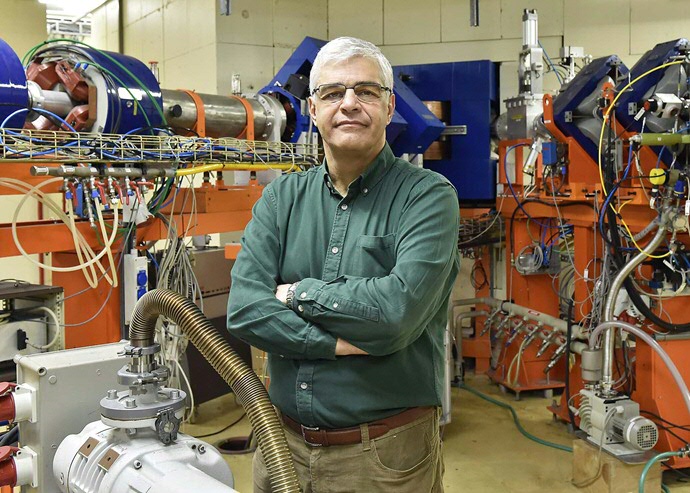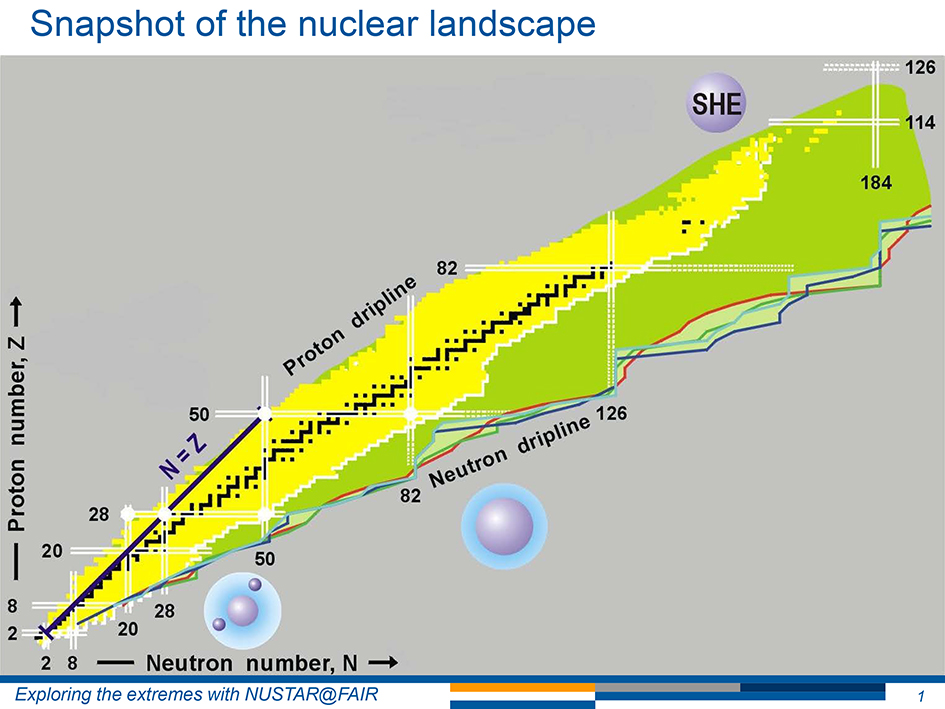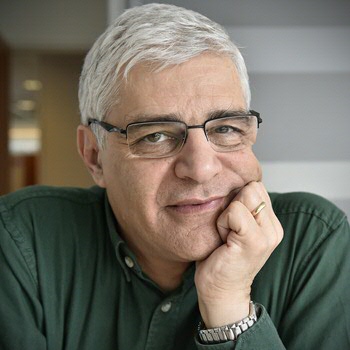Turning lead into knowledge

The ancient alchemists dreamed of turning lead into gold. But nuclear physicist Nasser Kalantar -Nayestanaki has other dreams: he wants to know how 82 protons and 126 neutrons stick together to form the nucleus of a lead atom. He has been chasing this dream at the KVI-CART research institute of the University of Groningen for well over twenty years.
Text: René Fransen / Photos: Elmer Spaargaren
Lead is heavy – we all know that. In fact, it is the heaviest stable element. And if you did any physics at school, you will know that the lead atom, like all atoms, is made up of positively charged protons and neutrons which have no charge. If you did some advanced physics, you will also know that the proton itself is made up of three quarks. And this is where things become a bit weird: we know the mass of these quarks, but the proton is about a hundred times heavier than the sum of the masses of the three quarks.
Collisions
Nasser Kalantar (Iran, 1960) explains how much we still don’t know about atoms in his office at the KVI-CART research facility on the Zernike Campus. ‘I started my work here in 1993, when the AGOR particle accelerator was being built. I did some of the first experiments it performed, studying the bremsstrahlung resulting from proton-proton collisions.’ The collisions generate photons that carry information on the nature of the interaction between the protons. ‘In the Large Hadron Collider at CERN, the collisions are at a much higher energy, so the protons are smashed and new particles are generated. You can therefore create and detect particles like Higgs, but you get no information on the protons themselves.’
Unstable atoms
From studying protons, Kalantar moved on to atomic nuclei. There are some three hundred stable nuclei, but also a vast number of unstable atoms that will decay over time. In some, like uranium, this decay process literally takes ages; others are gone in fractions of a second. ‘We have observed around three thousand of these unstable atoms, and there should be an equal number which we haven’t yet observed.’ But although physicists have information on quite a number of atomic nuclei, they still have no formula to describe how protons and neutrons interact to create them. Kalantar produces a graph with nuclei plotted by the number of protons and neutrons they possess. ‘You can add many neutrons to a certain number of protons, but not indefinitely. But we have no formula to describe which nuclei can exist, only models based on our observations. And these models don’t all agree as they still have many uncertainties.’

Lead dreams
As an experimental physicist, Kalantar tries to get more information from nuclei in order to improve the models. ‘At the moment, models based on “first principles” can relatively accurately describe nuclei with up to some 40 particles, which is a huge increase compared to some 20 years ago. But even then, we cannot accurately calculate all the interactions.’ Better models and faster computers could lead to a full understanding of the lead nucleus in another ten or 20 years, he thinks. ‘Understanding lead from the fundamental interactions of particles in the nucleus has been my dream throughout my career’, he admits. That dream started while he was doing his Bachelor’s degree in physics and mathematics in the US. ‘I got into nuclear physics more or less by coincidence, through a professor I met. We got on very well, and he interested me in a thesis project.’ Personal relationships are important to Kalantar. ‘Even in this digital age, I believe it is important to actually meet people.’

From MIT to Groningen
After graduating, he went on to do his Master’s degree at Brown University. From there, he moved to the Massachusetts Institute of Technology in Boston. ‘Towards the end of my PhD studies, I got married and we decided to move to Europe. We liked the European culture and political climate better.’ The Kalantar family ended up in the Netherlands. After a postdoc position at Nikhef (the National Institute for Subatomic Physics) and a tenured position at VU Amsterdam, Groningen beckoned. ‘I got a starting grant to do experiments with AGOR, the new accelerator that was then being built at the KVI.’ He moved to Groningen in 1993 and has lived here ever since. ‘I do like living here’, he says. ‘And the support of the Board of the University has always been excellent.’ Kalantar worked at the KVI research institute for nuclear physics, which was funded by the UG and FOM Foundation, now part of the Dutch funding organization NWO. In 2014, FOM ended its support for KVI. ‘The Board of the University stepped in to keep the institute afloat’, remembers Kalantar. ‘I really appreciated that.’ KVI was given a new lease of life as the KVI-Center for Advanced Radiation Technology (KVI-CART).
Dark cloud
Several years earlier, in 2008, another dark cloud loomed over Kalantar. A ruling was passed by the Dutch government, which banned people with dual Iranian and Dutch nationality from visiting certain facilities related to nuclear energy, or studies which might have anything to do with nuclear proliferation. Kalantar was by then a Dutch citizen, but still had his Iranian passport. ‘It is extremely complicated to renounce Iranian citizenship.’ Even his two sons, who were born in the Netherlands, have dual citizenship. ‘This meant that they weren’t free to study what they liked. And I couldn’t visit the nuclear research facility in Petten.’ Kalantar decided to challenge the ruling, together with two fellow Iranians. ‘We won the battle decisively, all the way up to the highest court. But it was a dark period. However, it was a victory for the freedom of education for all.’
Community
Over the years, Kalantar has taken to the Dutch way of life. ‘I think my work attitude is definitely Dutch. I’m very disciplined in that respect.’ In personal contacts, he remains Iranian. He laughs, ‘In a conversation, I may place my hand on someone’s shoulder. And I get up when someone enters the room and never turn my back on an older person.’ Iran is still very much part of his life: he goes there about once a year, to visit family. Although science is his main passion, Kalantar has been active in the community as well. He was appointed to the Minorities Council of the city of Groningen in 2001, which advised the municipality on social issues, and was chair for four years.
Very settled
But his work takes him abroad a lot these days. He is part of a large consortium of nuclear scientists who are building a CERN-like complex with lower energies but higher intensities and a larger variety of beams at the site of GSI Helmholtzzentrum für Schwerionenforschung in Darmstadt (Germany). ‘Over the past four years, I have been the spokesperson for NUSTAR , which, amongst many other things, will study how the elements are formed’, he explains. This project brings together some 800 scientists from around 180 research institutes in 39 countries. ‘Here at KVI-CART, we have built detectors to be used in Darmstadt.’ One thing that Kalantar will study is the compressibility of nuclei using a secondary particle beam generated from beams coming from the 1.1 kilometre circular accelerator that is under construction. ‘Again, these measurements will improve the models that describe how protons and neutrons move in a nucleus. Combined with other studies which I am also involved in, we will learn how the elements were formed in the stars and what some of the properties of the stars are.’ So, for the foreseeable future, Kalantar seems very settled in Groningen.
More information
More news
-
15 September 2025
Successful visit to the UG by Rector of Institut Teknologi Bandung
